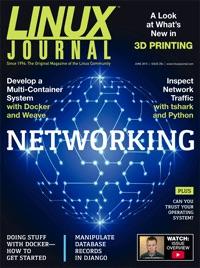June 2015 Issue of Linux Journal: Networking


Two Cups, One String
Whenever I watch episodes of Battlestar Galactica, it breaks my heart when they avoid Cylon hacking by disconnecting all networks. (It also annoys me how distorted the concept of networking is presented in the show, but I digress.) Anyone who has had their Wi-Fi go down knows just how much we depend on computer networks in our every day lives. In this issue, we focus on networking, because the most powerful computer in the world isn't nearly as awesome without the ability to search for cat videos on YouTube.
We start out with Reuven M. Lerner's column on Django models. No, that's not a runway of models showing off the new Django fashions; rather, Reuven explains how to manipulate database records from inside Django applications. He's followed by Dave Taylor, who delves into some insidious shell scripting issues that occur when dealing with data.
Kyle Rankin starts the first part of his series on 3D printing. Kyle has been interested in 3D printing since before it was "cool", and this month, you'll see how far the process has come in a few short years. 3D printing has hit the mainstream, and that's good news for those of us who were late to the game. We're way past the days of spending $1,000 to print a $0.17 plastic whistle, and Kyle brings us up to date.
My column this month is all about demystifying Docker. We've published some Docker articles in the past, but I never really understood Docker apart from what it was doing conceptually. I figured I probably wasn't alone, so I go through the process of learning how to use Docker in a project, and along the way I describe what it is, and how to use it. I hate intimidating technology, so hopefully this month we'll tame the Docker beast.
This is, of course, the networking issue. Federico Kereki follows my intro to Docker column with a more in-depth look at the networking aspect of containers. Using Docker and Weave, Federico shows how to build complete systems of networked containers in a way that is efficient and easy to configure. If you're not familiar with Docker, I recommend reading my column first, but you really don't want to miss Federico's awesome look at container-based networking.
Most networking-centric issues of a tech magazine would include an article on Wireshark—and rightly so. It's an amazing piece of software that does incredibly deep network inspections, and it does it all for free. Mihalis Tsoukalos covers tshark this month, which is a command-line version of Wireshark. Although tshark does all the same network capture and diagnoses of its brother, Wireshark, tshark does it without a GUI. This means that although you lose the pretty graphics, you gain the ability to script functionality and use tshark without the need to point and click. Mihalis shows how to store network capture data into MongoDB using all command-line tools.
Whether your networking prowess peaked when you tied two cups together with string or you pay your mortgage by managing a huge corporate network, this issue of Linux Journal should give you plenty of insight on all things network. We don't have any articles on how to keep Cylons out of your firewall, but apparently the only way to do that is to unplug your system anyway (sigh). This was a fun issue for us to put together, full of reviews, announcements, tech tips and more. We hope you enjoy it!
Available to Subscribers: June 1










